Embryonic origins of ZebrinII parasagittal stripes and establishment of topographic Purkinje cell projections
- PMID: 19150487
- PMCID: PMC2716412
- DOI: 10.1016/j.neuroscience.2008.12.025
Embryonic origins of ZebrinII parasagittal stripes and establishment of topographic Purkinje cell projections
Abstract
The establishment of neural circuits involves both the precise positioning of cells within brain regions and projection of axons to specific target cells. In the cerebellum (Cb), the medial-lateral (M-L) and anterior-posterior (A-P) position of each Purkinje cell (PC) and the topography of its axon can be defined with respect to two coordinate systems within the Cb; one based on the pattern of lobules and the other on PC gene expression in parasagittal clusters in the embryo (e.g. Pcp2) and stripes in the adult (e.g. ZebrinII). The relationship between the embryonic clusters of molecularly defined PCs and particular adult PC stripes is not clear. Using a mouse genetic inducible fate mapping (GIFM) approach and a Pcp2-CreER-IRES-hAP transgene, we marked three bilateral clusters of PC clusters with myristolated green fluorescent protein (mGfp) on approximately embryonic day (E) 15 and followed their fate into adulthood. We found that these three clusters contributed specifically to ZebrinII-expressing PCs, including nine of the adult stripes. This result suggests that embryonic PCs maintain a particular molecular identity, and that each embryonic cluster can contribute PCs to more than one adult M-L stripe. Each PC projects a primary axon to one of the deep cerebellar nuclei (DCN) or the vestibular nuclei in the brainstem in an organized fashion that relates to the position of the PCs along the M-L axis. We characterized when PC axons from the three M-L clusters acquire topographic projections. Using a combination of GIFM to mark the PC clusters with mGfp and staining for human placental alkaline phosphatase (hAP) in Pcp2-CreER-IRES-hAP transgenic embryos we found that axons from each embryonic PC cluster intermingled with neurons within particular DCN or projected out of the Cb toward the vestibular nuclei by E14.5. These studies show that PC molecular patterning, efferent circuitry, and DCN nucleogenesis occur simultaneously, suggesting a link between these processes.
Figures

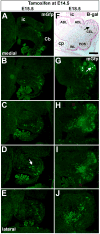
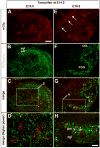


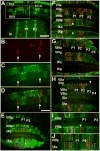
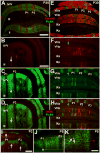
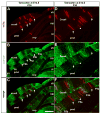

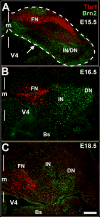
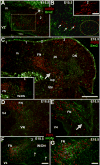
Similar articles
-
Engrailed homeobox genes determine the organization of Purkinje cell sagittal stripe gene expression in the adult cerebellum.J Neurosci. 2008 Nov 19;28(47):12150-62. doi: 10.1523/JNEUROSCI.2059-08.2008. J Neurosci. 2008. PMID: 19020009 Free PMC article.
-
From clusters to stripes: the developmental origins of adult cerebellar compartmentation.Cerebellum. 2006;5(2):77-88. doi: 10.1080/14734220600804668. Cerebellum. 2006. PMID: 16818382 Review.
-
Compartmental organization of Purkinje cells in the mature and developing mouse cerebellum as revealed by an olfactory marker protein-lacZ transgene.J Comp Neurol. 1999 Feb 1;404(1):97-113. doi: 10.1002/(sici)1096-9861(19990201)404:1<97::aid-cne8>3.3.co;2-t. J Comp Neurol. 1999. PMID: 9886028
-
Expression of the IP3R1 promoter-driven nls-lacZ transgene in Purkinje cell parasagittal arrays of developing mouse cerebellum.J Neurosci Res. 2010 Oct;88(13):2810-25. doi: 10.1002/jnr.22451. J Neurosci Res. 2010. PMID: 20632399
-
Cadherins in cerebellar development: translation of embryonic patterning into mature functional compartmentalization.Cerebellum. 2011 Sep;10(3):393-408. doi: 10.1007/s12311-010-0207-4. Cerebellum. 2011. PMID: 20820976 Review.
Cited by
-
Clustered fine compartmentalization of the mouse embryonic cerebellar cortex and its rearrangement into the postnatal striped configuration.J Neurosci. 2012 Nov 7;32(45):15688-703. doi: 10.1523/JNEUROSCI.1710-12.2012. J Neurosci. 2012. PMID: 23136409 Free PMC article.
-
Migration, early axonogenesis, and Reelin-dependent layer-forming behavior of early/posterior-born Purkinje cells in the developing mouse lateral cerebellum.Neural Dev. 2010 Sep 1;5:23. doi: 10.1186/1749-8104-5-23. Neural Dev. 2010. PMID: 20809939 Free PMC article.
-
Engrailed homeobox genes regulate establishment of the cerebellar afferent circuit map.J Neurosci. 2010 Jul 28;30(30):10015-24. doi: 10.1523/JNEUROSCI.0653-10.2010. J Neurosci. 2010. PMID: 20668186 Free PMC article.
-
Architecture and development of olivocerebellar circuit topography.Front Neural Circuits. 2013 Jan 2;6:115. doi: 10.3389/fncir.2012.00115. eCollection 2012. Front Neural Circuits. 2013. PMID: 23293588 Free PMC article.
-
Purkinje Cell Patterning-Insights from Single-Cell Sequencing.Cells. 2022 Sep 18;11(18):2918. doi: 10.3390/cells11182918. Cells. 2022. PMID: 36139493 Free PMC article. Review.
References
-
- Ahn AH, Dziennis S, Hawkes R, Herrup K. The cloning of zebrin II reveals its identity with aldolase C. Development. 1994;120:2081–2090. - PubMed
-
- Altman J, Bayer SA. Development of the Cerebellar System in Relation to its Evolution, Structure, and Functions. Boca Raton: CRC Press; 1997. p. 783.
-
- Armstrong CL, Krueger AM, Currie RW, Hawkes R. Constitutive expression of the 25 kDa heat shock protein Hsp25 reveals novel parasagittal stripes of Purkinje cells in the adult mouse cerebellar cortex. J Comp Neurol. 2000;416:383–397. - PubMed
-
- Armstrong CL, Krueger-Naug AM, Currie RW, Hawkes R. Expression of heat-shock protein Hsp25 in mouse Purkinje cells during development reveals novel features of cerebellar compartmentation. J Comp Neurol. 2001;429:7–21. - PubMed
Publication types
MeSH terms
Substances
Grants and funding
LinkOut - more resources
Full Text Sources
Molecular Biology Databases
Miscellaneous

